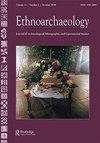Ethnoarchaeological Study of Noog (Guizotia abyssinica (L. f.) Cass., Compositae) in Ethiopia
IF 1.3
0 ARCHAEOLOGY
引用次数: 5
Abstract
ABSTRACT Ethnoarchaeological research was conducted on traditional agriculture and use of noog (Guizotia abyssinica (L.) Cass.) as well as its wild progenitor, mech (Guizotia scabra (Vis.) Chiov) in present day Ethiopia. The study revealed technological and social aspects of this oil crop. Various traditional processing methods (field and household), division of labor, and economical and cultural values are outlined and described. The study shows the probability of charred remains occurring as a result of field processing noog and household processing of noog and mech. It is, however, difficult to differentiate, based on residue composition, the various field processing activities because of similarity of components and absence of weed seeds associated with the noog crop. The tools used in the processing do not leave evidence in the archaeological record indicative of the presence of noog and mech.鲁格族(Guizotia abyssinica)的民族考古研究卡斯。,合成科)在埃塞俄比亚
摘要/ ABSTRACT摘要:对贵州传统农业及其利用进行了民族考古研究。)以及它的野生祖先,在今天的埃塞俄比亚的mech (Guizotia scabra (Vis.) Chiov)。这项研究揭示了这种油料作物的技术和社会方面。概述和描述了各种传统加工方法(田间和家庭)、劳动分工以及经济和文化价值。研究结果表明,野外加工和家庭加工的煤矸石和煤矸石发生焦化的可能性。然而,根据残留物组成,很难区分各种田间处理活动,因为成分相似,而且没有与noog作物相关的杂草种子。加工过程中使用的工具并没有在考古记录中留下noog和mech存在的证据。
本文章由计算机程序翻译,如有差异,请以英文原文为准。
求助全文
约1分钟内获得全文
求助全文
来源期刊

Ethnoarchaeology
ARCHAEOLOGY-
CiteScore
1.60
自引率
0.00%
发文量
10
期刊介绍:
Ethnoarchaeology, a cross-cultural peer-reviewed journal, focuses on the present position, impact of, and future prospects of ethnoarchaeological and experimental studies approaches to anthropological research. The primary goal of this journal is to provide practitioners with an intellectual platform to showcase and appraise current research and theoretical and methodological directions for the 21st century. Although there has been an exponential increase in ethnoarchaeological and experimental research in the past thirty years, there is little that unifies or defines our subdiscipline. Ethnoarchaeology addresses this need, exploring what distinguishes ethnoarchaeological and experimental approaches, what methods connect practitioners, and what unique suite of research attributes we contribute to the better understanding of the human condition. In addition to research articles, the journal publishes book and other media reviews, periodic theme issues, and position statements by noted scholars.
 求助内容:
求助内容: 应助结果提醒方式:
应助结果提醒方式:


